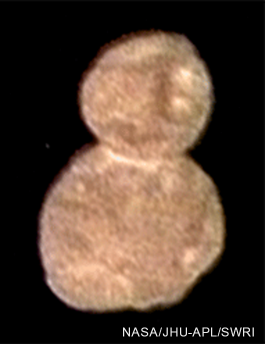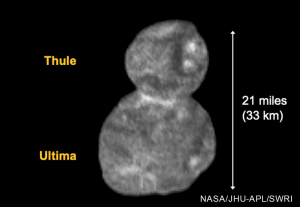
January 4, 2019, by Emma Rayner
Snowmen and Rubber Ducks: Why does humanity keep encountering amusingly bizarre objects in our Solar System?
By Ian Sheard, BSc (Hons), Physics – University of Nottingham 2014-2018. Media/Admin Assistant in the UoN Press Office.
Frosty the Snowman may well have been cold but he was nowhere near as frigid as Ultima Thule, the trans-Neptunian object (TNO) formally known by the less enticing moniker of 2014 MU69, which was visited by NASA’s New Horizons spacecraft on New Year’s Day.
Ultima Thule orbits the Sun in what’s known as the Kuiper belt; a region of the solar system beyond its furthest planet Neptune (sorry Pluto fans). That’s over 4.5 billion km from the Sun. Out there the light from the sun is so dim that temperatures are as low as -240⁰C.
Exploring distant objects
New Horizons was launched in 2006, with the original mission plan of performing a flyby study of Pluto and its moon Charon. After that was successfully completed in 2014, the mission was extended to use the same probe to study the nature of TNOs. These are among the oldest objects in the solar system, even older than the Earth.
The orbit of Ultima Thule was intercepted 6.5 billion km away. This makes it the most distant object ever explored in the solar system – a record that had previously been set by the New Horizons’ flyby of Pluto.
This morning, Professor Mike Merrifield, Head of the University of Nottingham’s School of Physics and Astronomy, was interviewed by BBC Radio Nottingham about New Horizons’ most recent encounter. During the interview he explained what’s so important about this far off object in the solar system is that Ultima Thule is left over from the formation of the solar system and it’s so small that not much has happened to it since then.
“It’s out there, in the outer solar system where it’s so cold chemistry has basically stopped. So really his thing is sort of like a time machine, that has trapped in it the formation of the solar system. In principle we could learn something about the way the system formed.”
Because it is now so far away, it takes the signal from New Horizons over 6 minutes to reach Earth, even travelling at the speed of light. As such it took a day for NASA to receive the first, grainy up-close images.
A very tall snowman
Up until the last few days before New Horizons’ flyby scientists still weren’t sure what to expect. Three days before the pass, Ultima Thule was still little more than a small collection of pixels on NASA’s computer screens, and contrary to their expectations, the team working on the project were still unsure exactly what this TNO was going to look like when they finally reached it.
Now we know. It looks like a snowman. A 33 km tall snowman.
For many people, this will evoke memories of the European Space Agency (ESA) Rosetta mission to land a probe, called Philae, on the 67P/Churyumov–Gerasimenko comet. A comet that that up until that point had been otherwise engaged, hurtling around the Sun at over 15 miles a second, generally minding its own business. That comet captured the public’s attention at the time because of its strong and remarkable resemblance to a rubber duck.
So, between snowmen and rubber ducks, why does humanity keep encountering bizarre and amusingly shaped objects in our solar system?
Well, the occurrences aren’t as uncommon as you might think. Over half of the comets observed by spacecraft have so-called two-lobed shapes; one object consisting of two spheroids joined together.
There are a number of ways this could have happened, though the New Horizons mission team reportedly believes that the two objects that coalesced to form Ultima Thule probably did so right at the beginning of, or soon after, the formation of the solar system, 4.5 billion years ago.
Slowly sticking together
Dr Jeff Moore from NASA’s Ames Research Center, who is a New Horizons co-investigator said the pair would have come together at a very small closing velocity, possibly slower than walking speed; he joked that “if you had a collision with another car at those speeds you may not even bother to fill out the insurance forms.”
“The idea,” exposited Professor Merrifield (who, for the avoidance of doubt, I should point out isn’t a member of the New Horizons team) to BBC Radio Nottingham, “is that at some point early in the formation of the solar system there were two separate bits and they very slowly bumped into each other and stuck.”
When asked by what process these two “bits” stuck together, the Nottingham based physicist explained that it may well have been a combination of gravity and other forces because of the amount of ice in space rocks: “ice is very sticky stuff so if they collided together and melted some of the ice in the collision process, when it refroze that would bond together very effectively. It’s like the old thing of not sticking your tongue on a steel post when it is freezing outside because you tongue will stick to it”
Since the New Horizons spacecraft has passed Ultima Thule, less than one per cent of the data gathered has made its way back. It will take the best part of 2 years for all the data gathered in its flyby to be transmitted back to Earth. Though the first images acquired at the point of closet approach (33,000km) are expected in February this year.
What’s next for the New Horizons probe?
New Horizons’ circuits are powered by a plutonium battery that still has plenty of life in it, and the probe may have fuel reserves sufficient enough to perform one more flyby of another trans-Neptunian object some time during the 2020s, before it finally leaves the solar system, never to return.
Writing this blog I have found two online articles to be valuable sources of information. They can be seen here and here. Additional information about the New Horizons project can be found here.
No comments yet, fill out a comment to be the first



Leave a Reply